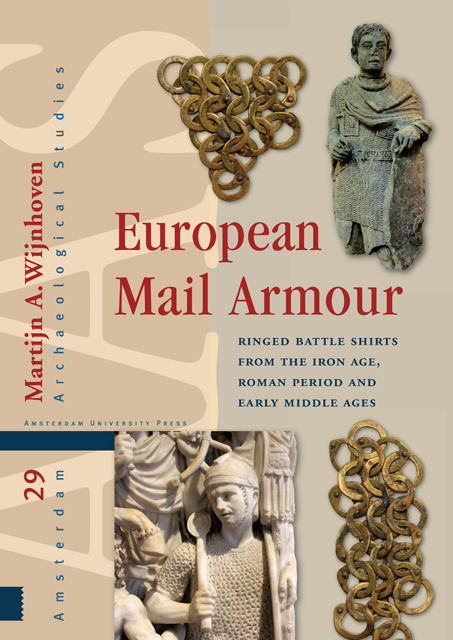Book contents
- Frontmatter
- Contents
- Acknowledgements
- Dedication
- 1 Introduction
- 2 The origins of mail armour
- 3 Distribution and archaeological context
- 4 The iconography of early mail armour
- 5 The naming of mail armour
- 6 Decoration in mail garments
- 7 Padded garments
- 8 The craft of making mail rings
- 9 Weaving patterns
- 10 The construction of mail garments
- 11 Ring characteristics
- 12 Final considerations
- Bibliography
- Database
- Appendix 1 Catalogue of mail armour
- Appendix 2 Catalogue of hybrid armour
- Appendix 3 Catalogue of isolated finds of fasteners and fixtures
- Appendix 4 Finds excluded from the database
1 - Introduction
Published online by Cambridge University Press: 24 November 2022
- Frontmatter
- Contents
- Acknowledgements
- Dedication
- 1 Introduction
- 2 The origins of mail armour
- 3 Distribution and archaeological context
- 4 The iconography of early mail armour
- 5 The naming of mail armour
- 6 Decoration in mail garments
- 7 Padded garments
- 8 The craft of making mail rings
- 9 Weaving patterns
- 10 The construction of mail garments
- 11 Ring characteristics
- 12 Final considerations
- Bibliography
- Database
- Appendix 1 Catalogue of mail armour
- Appendix 2 Catalogue of hybrid armour
- Appendix 3 Catalogue of isolated finds of fasteners and fixtures
- Appendix 4 Finds excluded from the database
Summary
‘Beowulf got ready, donned his war-gear, indifferent to death. His mighty, hand-forged, fine webbed mail would soon meet with the menace under water. It would keep the bone-cage of his body safe. No enemy's clasp could crush him in it, no vicious arm lock choke his life out.’
Beowulf (c. 8th century AD)
Mail armour, made of countless interlinked metal rings that protect the body, is a highly successful piece of military equipment. In warfare, where innovation is crucial to stay ahead, the development of weaponry can happen relatively quickly compared to the rate of change in other realms of society. Despite the fast-paced arms race which has been going on since antiquity, mail armour remained basically an Iron Age technology until it fell out of use in the 19th century. This means that it endured more than two thousand years of evolution of military equipment and battle tactics. Its use spread over vast geographical areas including Europe, Asia, North Africa and even the Americas during the Early Colonian period, indicating that it was an extraordinarily effective piece of protective gear in all kinds of battle conditions, places, and periods.
Although mail is no longer worn in combat, it continues to exist. Nowadays, its most common applications are in protective suits for scuba divers against shark bites, and in gloves or mittens to avoid injuries when working with sharp tools, for instance in professional kitchens. As a piece of defensive equipment, it lives in our collective consciousness as the archetypical outfit of military men from the remote past, and has been immortalized by popular culture appearing frequently on television, film, videogames, and literature.
The long lifespan and success of mail armour as a defensive garment is, however, not reflected in scholarship, where there are surprisingly few works that deal with this type of armour in depth. The following section introduces some key publications that outline the state of the field in mail research, leading up to the aims of this study.
PREVIOUS RESEARCH
Shortly after armour became obsolete on the European battlefields and turned into a historical item, studies of its development started to appear in the late 18th and early 19th centuries.
- Type
- Chapter
- Information
- European Mail ArmourRinged Battle Shirts from the Iron Age, Roman Period and Early Middle Ages, pp. 1 - 12Publisher: Amsterdam University PressPrint publication year: 2021



